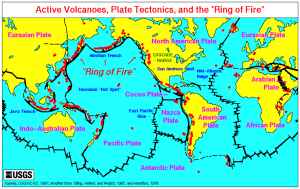

| Online: | |
| Visits: | |
| Stories: |
Red Alert: US West Coast Earthquake Imminent as Cascadia Subduction Zone Surges – a Supervolcano Waking up in the USA

Volcanoes are the biggest threat to human survival, claim scientists.
SCIENTISTS have warned the world is in “volcano season” and there is up to a 10% chance of an eruption soon killing millions of people and devastating the planet.
A supervolcano which in case of eruption will blow all of North America and doom half of the world to slow death is starting to wake up. Can’t we do anything about it?
First let’s decide on what is a supervolcano. It’s nothing like a regular volcano – a cone-shaped formation with a vent – it’s more of a huge depression with the eruption area covering a few thousand square kilometers. For instance, a supervolcanic eruption on the Indonesian island of Sumatra caused six years of sulfuric acid rains. Add to this the dust clouds blocking the sun for quite a while, and you will get a picture very similar to nuclear winter. The supervolcano left no more than ten thousand people on the entire planet.
Nowadays, there’s also a threat of volcano eruption. There is a supervolcano in Yellowstone National Park, USA, at the height of 2,500 meters. Until recently, it has been considered dormant. On the outside Yellowstone National Park is covered with a picturesque landscape, while on the inside it is a vast valley filled with molten magma.
READ MORE:
RUSSIA WARNS OF MEGA EARTHQUAKE COMING – Scientists Warn of Looming U.S. West Coast BIG ONE
Instances of volcanic eruptions are their highest for 300 years and scientists fear a major one that could kill millions and devastate the planet is a real possibility.
Experts at the European Science Foundation said volcanoes – especially super-volcanoes like the one at Yellowstone National Park, Wyoming, which has a caldera measuring 34 by 45 miles (55 by 72 km) – pose more threat to Earth and the survival of humans than asteroids, earthquakes, nuclear war and global warming.
There are few real contingency plans in place to deal with the ticking time bomb, which they conclude is likely to go off within the next 80 years.
The world’s most dangerous active volcanoes include Yellowstone, Mount Vesuvius in Campagnia, Italy, and Popocatépetl i near Mexico City.
If any of them or other massive volcanic peaks suffered a major eruption the team said millions of people would die and earth’s atmosphere would be poisoned with ash and other toxins “beyond the imagination of anything man’s activity and global warming could do over 1,000 years.
The chance of such as eruption happening at one of the major volcanoes within 80 years is put at five to ten per cent by the experts.

Yellowstone does not appear like many volcanoes but is believed to have the most magma underneath
There are already fears that Yellowstone could blow any time within the next 70 years on a scale that would wiped out the western USA and affect the course of global history.
The report – “Extreme Geo-hazards: Reducing the Disaster Risk and Increasing Resilience,” warns global government’s preparations for such happenings are virtually non-existent.
RECOMMENDED:
Learn How Planning Ahead Can Help You Protect Your Family, Your Home And Your Belongings In A Dangerous Time. The 3 Pioneer Survival Lessons We Should All Learn! The best plan for you and your family in major crisis. Here’s your chance Watch this free video.

It said: “Although in the last few decades earthquakes have been the main cause of fatalities and damage, the main global risk is large volcanic eruptions that are less frequent but far more impactfull than the largest earthquakes.”
“Due to their far-reaching effects on climate, food security, transportation, and supply chains, these events have the potential to trigger global disaster and catastrophe.
“The cost of response and the ability to respond to these events is beyond the financial and political capabilities of any individual country.”

We are currently in a global volcano season, say scientists
“Hence extreme volcanic eruptions pose a higher associated risk than all other natural hazards with similar recurrence periods, including asteroid impacts.”
Extreme Geo-hazards: Reducing the Disaster Risk and Increasing Resilience report.
The report looked at other major geo-hazards facing the globe, including earthquakes, drought, asteroids floods, tsunamis, hurricanes, avalanches and wildfires.
Large earthquakes and tsunamis have happened more in the last 2,000 years, meaning there was better preparedness.
The report concluded: “Volcanic eruptions can have more severe impacts through atmospheric and climate effects and can lead to drastic problems in food and water security, as emphasized by the widespread famine and diseases that were rampant after the Laki 1783 and Tambora 1815 eruptions.
“Hence extreme volcanic eruptions pose a higher associated risk than all other natural hazards with similar recurrence periods, including asteroid impacts.”
The eruption of Tambora on Sumbawa, Indonesia killed about 100,000 people, but ash clouds meant there was no summer the following year and it was “one of the most important climatic and socially repercussive events of the last millennium,” the report said.
The earlier Icelandic event killed close to 10,000 instantly, but the long-term, effects wiped out 25% of the population and were felt across the planet.
A famine in Egypt reduced the population by one sixth, 25,000 died in the UK from breathing problems and there was worldwide extreme weather.
Similar scale events today would be much more catastrophic, the team warned, due to much bigger populations, global travel and food chains and reliance on technology.
Worryingly, scientists say research over the last 300 years of volcanic activity shows we are currently in a “volcano season” meaning increased activity.
Volcanoes are also more likely from November to April in the northern hemisphere when ice, rain and snowfall can compress the bedrock.
Learn how planning ahead can help you protect your family, your home and your belongings in a dangerous earthquake.Video below




